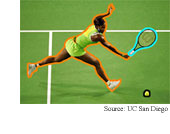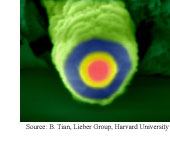
|
October
29/
November 5, 2007
 |
|
|  |
|
NEWS
|
Seeing in context
 Experimental software gives computer vision systems
a sense of context so the systems can more accurately
label objects in images. The software uses the Google
Sets lists of related items to give computers a rudimentary
common sense about things in the world. (Objects
in Context, ICCV 2007 – the 11th IEEE International
Conference on Computer Vision, Rio de Janeiro, Brazil,
October 18, 2007)
Experimental software gives computer vision systems
a sense of context so the systems can more accurately
label objects in images. The software uses the Google
Sets lists of related items to give computers a rudimentary
common sense about things in the world. (Objects
in Context, ICCV 2007 – the 11th IEEE International
Conference on Computer Vision, Rio de Janeiro, Brazil,
October 18, 2007)
Nanowire solar cells
 Coaxial silicon nanowires work as infinitesimal
solar cells, converting sunlight to electricity as efficiently
as 3.4 percent. Individual solar cell nanowires could
power nanoscale circuits and machines. (Coaxial
Silicon Nanowires as Solar Cells and Nanoelectronic Power
Sources, Nature, October 18, 2007)
Coaxial silicon nanowires work as infinitesimal
solar cells, converting sunlight to electricity as efficiently
as 3.4 percent. Individual solar cell nanowires could
power nanoscale circuits and machines. (Coaxial
Silicon Nanowires as Solar Cells and Nanoelectronic Power
Sources, Nature, October 18, 2007)
Nanotube radio
Carbon nanotubes work as tiny AM radio receivers;
in one experiment the microscopic tubes received and decoded
high-fidelity audio signals. Carbon nanotubes could be
used to further miniaturize wireless communications devices.
(Carbon
Nanotube Radio, Nano Letters, published online
October 17, 2007)
Cell rolling
A surface coated with the protein P-selectin causes
cells in fluids flowing across them to contact the surface
and slowly roll across. The technique, which mimics processes
in blood vessels that allow cells to communicate with
surrounding tissue, could lead to medical devices that
treat specific types of cells, including cancer cells.
(Covalent
Immobilization of P-Selectin Enhances Cell Rolling,
Langmuir, published online October 20, 2007)
Colorful gel
A gel made from two types of polymers, one hydrophobic
and the other hydrophilic, changes color in response to
changes in pressure, humidity and temperature and substances
like salt. The gel could be used to make fast, inexpensive
chemical sensors. (Broad-Wavelength-Range
Chemically Tunable Block-Copolymer Photonic Gels,
Nature Materials, published online October 21,
2007)
Nanoparticle fuel-cell parts
Nanoparticles made of platinum shells and copper-cobalt-platinum
alloy cores readily take up electrons from oxygen. They
are four to five times more efficient than bulk platinum
as cathodes in polymer electrolyte fuel cells. Cathodes
process the oxygen half of the oxygen-hydrogen reaction
that generates electricity in fuel cells. (Efficient
Oxygen Reduction Fuel Cell Electrocatalysis on Voltammetrically
De-alloyed Pt-Cu-Co Nanoparticles, Angewandte Chemie
International Edition, published online September
24, 2007) |
FEATURES
|
View
from the High Ground: ICL's John Pendry
Physics as machine tool, negative refractive
index, metamaterials, shattered wine glasses, higher capacity
DVDs, scientific backwaters, risk perception and practice,
practice, practice.
|
How
It Works: Quantum computing: qubits
Photons, electrons and atoms, oh my! These particles are
the raw materials for qubits, the basic building blocks
of quantum computers. |
|
 |
News RSS feed 
Blog RSS feed 
Bookshelf RSS feed

New: TRN's
Internet Services
TRN's Jobs Center
|
| |
|
| |
|
| |
"Physics
is to the rest of science what machine tools are
to engineering. A corollary is that science places
power in our hands which can be used for good or
ill. Technology has been abused in this way throughout
the ages from gunpowder to atomic bombs."
- John Pendry, Imperial College London |
|
| |
|
| |
Thanks
to Kevin from
GoldBamboo.com
for technical support |
|

